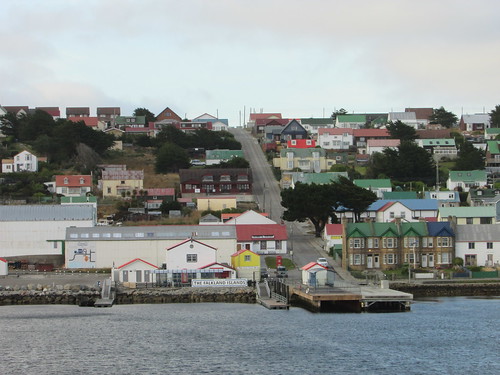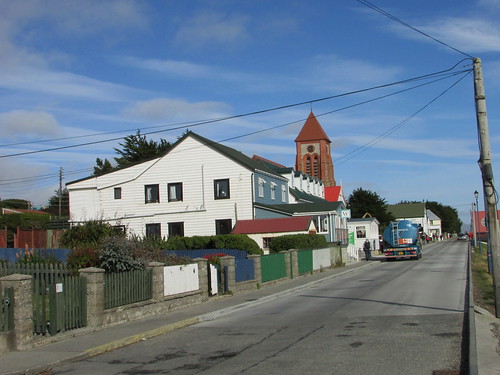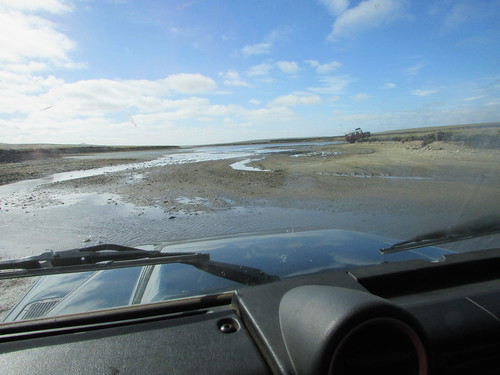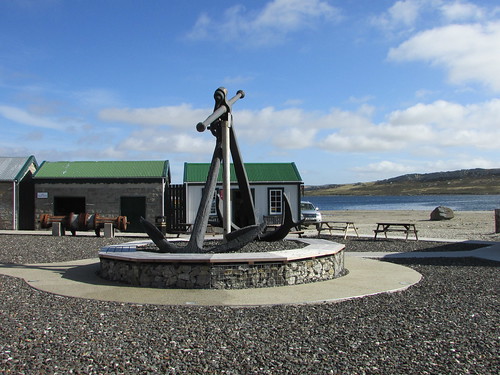Events of Friday, 4th March 2016
After leaving West Point Island, the ship then sailed eastwards during Thursday night, passing firstly West Falkland and then East Falkland, leaving both islands to our starboard. Once clear of East Falkland, the ship turned south to reach the ‘indentation’ in the coast line which led to Stanley. Here, we were sailing west briefly, passing one cargo ship at anchor, awaiting its turn to offload. Stanley Harbour is an oval body of water lying east-west and very protected because the only entrance is via a small opening between Engineer Point (to port) and Navy Point (to starboard), requiring the Captain to turn south again. The main wharves lay ahead, on the south shore of Stanley Harbour with a number of ships in view. Finally, we sailed west again until we were opposite the town itself and its Public Jetty. We anchored in the middle of Stanley Harbour, with good views of the town.
 View of Stanley from the ship.
View of Stanley from the ship.
A road trip to Bluff Cove, on the southern coast of the island a few miles west of Stanley had been offered, with the passengers divided into two groups being picked up on shore at nine o’clock and ten o’clock, after transferring from the ship by Zodiac.
I was in the later group but went ashore as soon as transfer of the early group had been ferried to land. Brightly-coloured houses, none more than two stories high lined a number of streets, each running parallel to a promenade on the shoreline. A few of the buildings were brick, in late British Victorian style but most appeared to be wooden-clad with corrugated iron (‘tin’) roofs. Quite a few buildings appeared to have had the wooden weatherboarding replaced by modern plastic ‘planks’ (probably uPVC). I walked west along the promenade, Ross Road, past the Anglican Cathedral, Police Headquarters (including a prison), Catholic Church, the Department of Mineral Resources, the Bank, the Post Office (with traditional British telephone kiosks outside) and the offices of the local newspaper (‘The Penguin’).
 Ross Road, Stanley.
Ross Road, Stanley.
Opposite the ‘Malvina House Hotel’ (named, I was later assured, after the owner’s daughter and not to show sympathy with Argentinian territorial claims) I found the delightful ‘Historic Dockyard Museum’, which provided a very professional display of all aspects of the history and community of the Falklands. Just after ten o’clock, a 16-seat coach picked a group of us up outside the museum but I returned later in the day to this fascinating location.
The 16-seat coach was one of a fleet which took us to Bluff Cove Lagoon. The road climbed out of Stanley past the hospital, power station (with a number of diesel generators) and a satellite earth station to take the tarmac road leading across the rather desolate, rock-strewn plain to the airport. Temporary traffic lights controlled a short section of road where a group of men dressed in the familiar fluorescent yellow aided by modern machinery were engaged in resurfacing work. We passed a quarry on our left which provides stone for building projects, near a group of six wind turbines which, we were told, provides up to one third of the island’s power when the wind is favourable.
As a grim reminder of the 1982 Falklands War, the heathland on the seaward side was fenced off with barbed wire, frequently displaying fading ‘MINES’ notices. Apparently, private contractors are engaged in the work of mine removal. As always, the consequences of war are felt long after the conflict has ceased.
Our coach pulled off the road at an isolated car park, to join two similar coaches and a number of Land Rovers. We divided up into various Land Rovers which set off, in convoy, on a rough farm track leading to the sea.
 A convoy of Land Rovers took us to Bluff Cove Lagoon.
A convoy of Land Rovers took us to Bluff Cove Lagoon.
The need for rugged vehicles soon became apparent as we bounced along the track and forded a stream so we were quite relieved to leave the vehicle when it parked on grassland next to a white beach. We had arrived at Bluff Cove, a 35,000 acre sheep farm which is also host to 1,000 breeding pairs of Gentoo penguins, a small number of King penguins and visiting Magellan penguins, together with various wild birds. Our enjoyable visit ended with tea and cake in the ‘Sea Cabbage Café’, including scones with jam made from the berries of the local wild Diddle Dee, before boarding Land Rovers for the return journey.
This time, the Land Rovers took us all the way back to Stanley and gave us a short town tour before dropping us near Ross Road. We had some free time to explore the town, shop, have lunch in town or return on the Zodiac shuttle service to the ship for lunch. I stayed in town, dividing my time between the museum, visiting the Cathedral (actually parish-church sized) and taking photographs around the town.
 Some of the museum buildings with Stanley Harbour in the background.
Some of the museum buildings with Stanley Harbour in the background.
The last Zodiac back to our waiting ship anchored in Stanley Harbour was advertised for 3.30 p.m. but I returned a little before the last boat. Once everyone was aboard and the cranes had retrieved all the Zodiacs, we reversed our morning’s route to reach open sea again.
Back in open water, our course was slightly south of due east. We would next have two full days sailing across the Scotia Sea to reach land at South Georgia.
Related posts
Next South Atlantic post.
All my South Atlantic posts.
My pictures
You can find all my pictures on the trip in the Collection Cape to Cape (still being added to, at the time of writing).
There are a few pictures of the trip in the album South Atlantic Voyage.
['Cape to Cape' collection added 5-Apr-2016]
